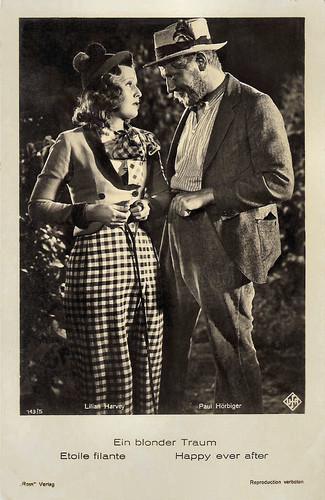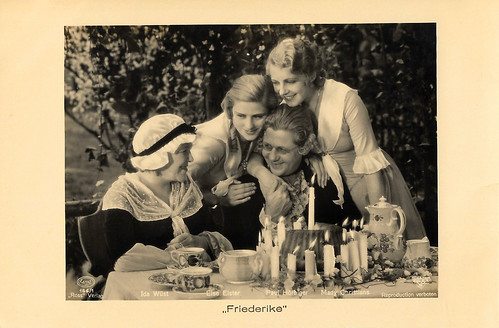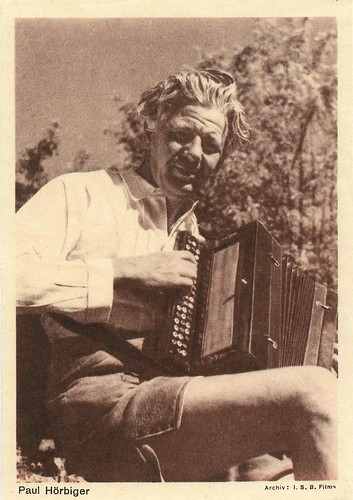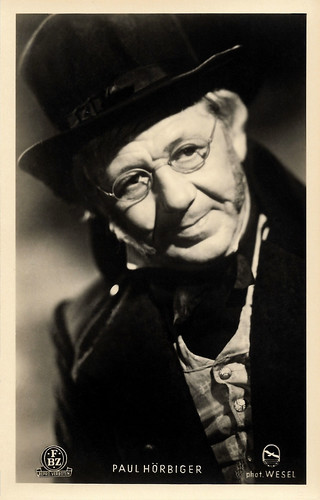Austrian stage and film actor Paul Hörbiger (1894-1981) belongs together with Hans Moser to the ‘primary rock’ of the Austrian cinema. His popularity was unique and was reflected in over 250 films, mostly lightweight comedies of the popular Wiener Film genre.

German cigarette card in the series Unsere Bunten Filmbilder by Ross Verlag for Cigarettenfabrik Josetti, Berlin, no. 240. Photo: Patria-Film.

German postcard by Ross Verlag, no. 7208/1, 1932-1933. Photo: Ufa.

German postcard by Ross Verlag, no. A 3118/1, 1941-1944. Photo: Terra / Wien-Film. Paul Hörbiger in Der liebe Augustin/The Dear Augustin (E.W. Emo, 1940).

German postcard by Ross Verlag, no. A 3337/2, 1941-1944. Photo: Terra.

Austrian postcard by Verlag Hubmann, Wien, no. 91. Photo: Union Film, Wien. Paul Hörbiger in Der Zigeunerbaron/The Gypsy Baron (Arthur Maria Rabenalt, 1954).
Paul Hörbiger was born in Budapest, Austria-Hungary (now Hungary) in 1894. He was the son of Hans Hörbiger, an engineer who wrote 'Welteislehre' on glacial cosmology.
In 1902 his family returned to Vienna, while Paul attended the gymnasium (grammar school) at St. Paul's Abbey in the Lavanttal. In the First World War, he served in a mountain artillery regiment of the Austro-Hungarian Army, discharged in 1918 with the rank of an Oberleutnant.
After the war, he attended shortly the Otto Theatre school and made his stage debut in 1919 at the city theatre of Liberec (Reichenberg). From 1920 he performed at the Neuen Deutschen Theater (New German Theatre) in Prague.
In 1926, with a contract for Max Reinhardt's Deutsches Theater in Berlin, he made his breakthrough.
In the silent era, he impersonated witty and vicious characters in such films as the classic Spione/Spies (Fritz Lang, 1928) with Willy Fritsch and Lien Deyers, Schmutziges Geld/Show Life (Richard Eichberg, 1928) starring Anna May Wong, and another classic, Asphalt (Joe May, 1929) with Gustav Fröhlich.

German postcard by Ross Verlag, no. 6101/1, 1931-1932. Photo: Ufa.

German postcard by Ross Verlag, no. 6754/1, 1931-1932. Photo: Atelier Zander & Labisch, Berlin.

German postcard by Ross Verlag, no. 131/8. Photo: Ufa. Paul Hörbiger in Der Kongress Tanzt/The Congress Dances (Erik Charell, 1931).

German postcard by Ross Verlag, no. 141/5, 1931-1932. Photo: Ufa. Hans Albers, Paul Hörbiger, Paul Westermeier and Genia Nikolaieva in Quick (Robert Siodmak, 1931).

German postcard by Ross Verlag, no. 143/5. Photo: Ufa. Lilian Harvey and Paul Hörbiger in Ein blonder Traum/Happy Ever After (Paul Martin, 1932).

German postcard by Ross Verlag no. 166/1. Photo: Indra-Film / Rolf Raffé. Ida Wüst, Else Elster, Paul Hörbiger and Mady Christians in Friederike/Frederica (Fritz Friedmann-Frederich, 1932).
Paul Hörbiger's film image was subsequently shaped by the sound film comedies and operettas of Géza von Bolváry and Erik Charell. This can best be seen in the warm-hearted Viennese character ‘Feschak’, and most clearly in the figure of the old Weiring in Liebelei/Flirtation (Max Ophüls, 1933).
Other interesting films from this period are Der Kongress Tanzt/The Congress Dances (Erik Charell, 1931) starring Lilian Harvey, Es war einmal ein Walzer/Once There Was A Waltz (Victor Janson, 1932) starring Márta Eggerth, Quick (Robert Siodmak, 1932), and Scampolo, ein Kind der Straße/Scampolo, a Child of the Streets (Hans Steinhoff, 1932) featuring Dolly Haas.
Then followed hits like Walzerkrieg/The Battle of the Walzes (Ludwig Berger, 1933) with Renate Müller, Königswalzer/The Royal Waltz (Herbert Maisch, 1935) and Kitty und die Weltkonferenz/Kitty and the World Conference (Helmut Käutner, 1939) with Hannelore Schroth.
In 1935 he founded the Algefa film company together with director E.W. Emo and consul Karl Künzel.

German postcard by Ross Verlag, no. 7635/1, 1932-1933. Photo: Dr. Weller, Berlin.

German postcard by Ross Verlag, no. 173/1. Photo: Phoebus Tonfilm. Lee Parry and Paul Hörbiger in Keinen Tag ohne Dich/ Wovon soll der Schornstein rauchen/No Day Without You (Hans Behrendt, 1933).

German postcard by Ross Verlag, no. 8288/2, 1933-1934. Photo: Yva, Berlin.

German Postcard by Ross Verlag, no. A 3337/1, 1941-1944. Photo: Hämmerer.

German postcard by Film-Foto-Verlag, no. A 3495/1, 1941-1944. Photo: Hämmerer / Wien-Film.

German Postcard by Film-Foto-Verlag, no. A 3766/1, 1941-1944. Photo: Siegel / Metropolfilm.
From 1940 on, Paul Hörbiger was a member of the Viennese Burgtheater. During the war, he acted in films like Operette/Operetta (Willi Forst, a.o., 1940) and Wen die Götter lieben/Whom the Gods Love (Karl Hartl, 1942) starring Hans Holt as Wolfgang Amadeus Mozart.
These were often lightweight comedies of the Wiener Film genre, which was popular among German and Austrian audiences during the 1930s and 1940s. Hörbiger often played roles similar to those of Hans Moser: waiters, servants, cab drivers, porters as well as ballad singers and singers during wine festivities.
He also frequently plays such Austrian greats as Franz Joseph II, Haydn or Radetzky. He and Moser complemented one another brilliantly in such films as Wiener Geschichten/Viennese Stories (Géza von Bolváry, 1940), Schwarz auf weiß/Black on White (E.W. Emo, 1943) and Schrammeln/Strum (Géza von Bolváry, 1944).
Though in 1938 he openly acclaimed the Austrian Anschluss to Nazi Germany and smoothly continued his career in Propaganda films like Wunschkonzert/Request Concert (Eduard von Borsody, 1940) or Die grosse Liebe/The Great Love (Rolf Hansen, 1942) starring Zarah Leander, he was arrested in Vienna in the late days of World War II.
The Nazis accused him of high treason. The BBC already reported his death, but Paul Hörbiger survived the war.

Dutch postcard, no. 587. Photo: City Film. Publicity still for Gruss und Kuss - Veronika (Carl Boese, 1933) with Franciska Gaál.

Dutch postcard by M. B. & Z, (M. Bonnist & Zonen, Amsterdam), no. 1107. Sent by mail in 1941. Photo: Sonora Film.

Austrian postcard by Eberle Verlag, Wien (Vienna), no. 48. Photo: I.S.B. Films. In 1948, Paul Hörbiger narrated the film A Door Stands Open (directed by Karl Sztollar and with music by Robert Stolz). produced by the Information Services Branch (I.S.B.). The I.S.B. was the central agency in charge of cultural diplomacy in Austria after WW II. Sources: Reinhold Wagnleitner (Coca-Colonization and the Cold War) and Lary May (Recasting America: Culture and Politics in the Age of Cold War).

Austrian postcard by Eberle-Verlag, Wien (Vienna). Photo: I.S.B. Films.

West-German postcard by F.B.Z. Photo: Wesel. Paul Hörbiger in Der Bagnosträfling/The Prisoner (Gustav Fröhlich, 1949).
After the war, Paul Hörbiger remained one of the most popular German-speaking film actors. He played a small role as the intimidated doorman in the classic The Third Man (Carol Reed, 1949). More demanding roles followed in Das Tor zum Paradies/The Strange Story of Brandner Kaspar (Josef von Báky, 1949), Epilog: Das Geheimnis der Orplid/Epilogue (Helmut Käutner, 1950) and Hallo Dienstmann/Hello Dienstmann (Franz Antel, 1951).
Yet, soon the old stereotypical roles returned in Viennese Swindel films. He also starred in numerous Heimatfilme, again performing as the warm-hearted Viennese type and the Heurigen singer, often together with Hans Moser and director Franz Antel.
His best-known films of these years include Mädchenjahre einer Königin/The Story of Vickie (Ernst Marischka, 1954) featuring Romy Schneider, Banditen der Autobahn/Bandits of the Highway (Géza von Cziffra, 1955), and Sebastian Kneip (Wolfgang Liebeneiner, 1958) with Carl Wery.
In his later years, he focused on stage acting at the Burgtheater. He also had stage appearances in Zürich, Moscow, and New York as well as in West Germany and Israel. In 1969 he received the Filmband in Gold Award for his longtime contributions to German cinema.
He was married to actress Josepha Gettke, with whom he had four children. He was the father of actor Thomas Hörbiger, grandfather of actor Christian Tramitz and actress Mavie Hörbiger, brother of actor Attila Hörbiger and uncle of actress Christiane Hörbiger. Paul Hörbiger died in 1981 in Vienna, Austria. He was 86.

West-German postcard by Kunst und Bild, Berlin, no. A 376. Photo: Gundlach / Union-Film. Paul Hörbiger in Der fidele Bauer/The Merry Farmer (Georg Marischka, 1951).

West-German postcard by Rüdel-Verlag. Photo: Erma / Herzog-Film / Czerwonski. Paul Hörbiger in Mädchenjahre einer Königin/The Story of Vickie (Ernst Marischka, 1954).

West-German postcard by Kolibri-Verlag G.m.b.H., Minden/Westf., no. 2047. Photo: Rhombus / Herzog-Film / Appelt. Gunther Philipp, Paul Hörbiger and Joachim Fuchsberger in Lumpazivagabundus (Franz Antel, 1956).

German postcard by Agfa, no 506. Photo: Panorama Film. Herta Staal and Paul Hörbiger in Die Winzerin von Langenlois/The Winemaker from Langenlois (Hans H. König, 1957).

West-German postcard by Ufa/Film-Foto, Berlin-Tempelhof, no. FK 3758. Photo: Gruber / Donau Film / NF. The retail price was 25 Pfg.
Sources: Thomas Staedeli (Cyranos), Filmportal.de, Steffi-line.de, Wikipedia (English and German), and IMDb.
This post was last updated on 19 October 2024.

German cigarette card in the series Unsere Bunten Filmbilder by Ross Verlag for Cigarettenfabrik Josetti, Berlin, no. 240. Photo: Patria-Film.

German postcard by Ross Verlag, no. 7208/1, 1932-1933. Photo: Ufa.

German postcard by Ross Verlag, no. A 3118/1, 1941-1944. Photo: Terra / Wien-Film. Paul Hörbiger in Der liebe Augustin/The Dear Augustin (E.W. Emo, 1940).

German postcard by Ross Verlag, no. A 3337/2, 1941-1944. Photo: Terra.

Austrian postcard by Verlag Hubmann, Wien, no. 91. Photo: Union Film, Wien. Paul Hörbiger in Der Zigeunerbaron/The Gypsy Baron (Arthur Maria Rabenalt, 1954).
Breakthrough
Paul Hörbiger was born in Budapest, Austria-Hungary (now Hungary) in 1894. He was the son of Hans Hörbiger, an engineer who wrote 'Welteislehre' on glacial cosmology.
In 1902 his family returned to Vienna, while Paul attended the gymnasium (grammar school) at St. Paul's Abbey in the Lavanttal. In the First World War, he served in a mountain artillery regiment of the Austro-Hungarian Army, discharged in 1918 with the rank of an Oberleutnant.
After the war, he attended shortly the Otto Theatre school and made his stage debut in 1919 at the city theatre of Liberec (Reichenberg). From 1920 he performed at the Neuen Deutschen Theater (New German Theatre) in Prague.
In 1926, with a contract for Max Reinhardt's Deutsches Theater in Berlin, he made his breakthrough.
In the silent era, he impersonated witty and vicious characters in such films as the classic Spione/Spies (Fritz Lang, 1928) with Willy Fritsch and Lien Deyers, Schmutziges Geld/Show Life (Richard Eichberg, 1928) starring Anna May Wong, and another classic, Asphalt (Joe May, 1929) with Gustav Fröhlich.

German postcard by Ross Verlag, no. 6101/1, 1931-1932. Photo: Ufa.

German postcard by Ross Verlag, no. 6754/1, 1931-1932. Photo: Atelier Zander & Labisch, Berlin.

German postcard by Ross Verlag, no. 131/8. Photo: Ufa. Paul Hörbiger in Der Kongress Tanzt/The Congress Dances (Erik Charell, 1931).

German postcard by Ross Verlag, no. 141/5, 1931-1932. Photo: Ufa. Hans Albers, Paul Hörbiger, Paul Westermeier and Genia Nikolaieva in Quick (Robert Siodmak, 1931).

German postcard by Ross Verlag, no. 143/5. Photo: Ufa. Lilian Harvey and Paul Hörbiger in Ein blonder Traum/Happy Ever After (Paul Martin, 1932).

German postcard by Ross Verlag no. 166/1. Photo: Indra-Film / Rolf Raffé. Ida Wüst, Else Elster, Paul Hörbiger and Mady Christians in Friederike/Frederica (Fritz Friedmann-Frederich, 1932).
Warmhearted Viennese
Paul Hörbiger's film image was subsequently shaped by the sound film comedies and operettas of Géza von Bolváry and Erik Charell. This can best be seen in the warm-hearted Viennese character ‘Feschak’, and most clearly in the figure of the old Weiring in Liebelei/Flirtation (Max Ophüls, 1933).
Other interesting films from this period are Der Kongress Tanzt/The Congress Dances (Erik Charell, 1931) starring Lilian Harvey, Es war einmal ein Walzer/Once There Was A Waltz (Victor Janson, 1932) starring Márta Eggerth, Quick (Robert Siodmak, 1932), and Scampolo, ein Kind der Straße/Scampolo, a Child of the Streets (Hans Steinhoff, 1932) featuring Dolly Haas.
Then followed hits like Walzerkrieg/The Battle of the Walzes (Ludwig Berger, 1933) with Renate Müller, Königswalzer/The Royal Waltz (Herbert Maisch, 1935) and Kitty und die Weltkonferenz/Kitty and the World Conference (Helmut Käutner, 1939) with Hannelore Schroth.
In 1935 he founded the Algefa film company together with director E.W. Emo and consul Karl Künzel.

German postcard by Ross Verlag, no. 7635/1, 1932-1933. Photo: Dr. Weller, Berlin.

German postcard by Ross Verlag, no. 173/1. Photo: Phoebus Tonfilm. Lee Parry and Paul Hörbiger in Keinen Tag ohne Dich/ Wovon soll der Schornstein rauchen/No Day Without You (Hans Behrendt, 1933).

German postcard by Ross Verlag, no. 8288/2, 1933-1934. Photo: Yva, Berlin.

German Postcard by Ross Verlag, no. A 3337/1, 1941-1944. Photo: Hämmerer.

German postcard by Film-Foto-Verlag, no. A 3495/1, 1941-1944. Photo: Hämmerer / Wien-Film.

German Postcard by Film-Foto-Verlag, no. A 3766/1, 1941-1944. Photo: Siegel / Metropolfilm.
High treason
From 1940 on, Paul Hörbiger was a member of the Viennese Burgtheater. During the war, he acted in films like Operette/Operetta (Willi Forst, a.o., 1940) and Wen die Götter lieben/Whom the Gods Love (Karl Hartl, 1942) starring Hans Holt as Wolfgang Amadeus Mozart.
These were often lightweight comedies of the Wiener Film genre, which was popular among German and Austrian audiences during the 1930s and 1940s. Hörbiger often played roles similar to those of Hans Moser: waiters, servants, cab drivers, porters as well as ballad singers and singers during wine festivities.
He also frequently plays such Austrian greats as Franz Joseph II, Haydn or Radetzky. He and Moser complemented one another brilliantly in such films as Wiener Geschichten/Viennese Stories (Géza von Bolváry, 1940), Schwarz auf weiß/Black on White (E.W. Emo, 1943) and Schrammeln/Strum (Géza von Bolváry, 1944).
Though in 1938 he openly acclaimed the Austrian Anschluss to Nazi Germany and smoothly continued his career in Propaganda films like Wunschkonzert/Request Concert (Eduard von Borsody, 1940) or Die grosse Liebe/The Great Love (Rolf Hansen, 1942) starring Zarah Leander, he was arrested in Vienna in the late days of World War II.
The Nazis accused him of high treason. The BBC already reported his death, but Paul Hörbiger survived the war.

Dutch postcard, no. 587. Photo: City Film. Publicity still for Gruss und Kuss - Veronika (Carl Boese, 1933) with Franciska Gaál.

Dutch postcard by M. B. & Z, (M. Bonnist & Zonen, Amsterdam), no. 1107. Sent by mail in 1941. Photo: Sonora Film.

Austrian postcard by Eberle Verlag, Wien (Vienna), no. 48. Photo: I.S.B. Films. In 1948, Paul Hörbiger narrated the film A Door Stands Open (directed by Karl Sztollar and with music by Robert Stolz). produced by the Information Services Branch (I.S.B.). The I.S.B. was the central agency in charge of cultural diplomacy in Austria after WW II. Sources: Reinhold Wagnleitner (Coca-Colonization and the Cold War) and Lary May (Recasting America: Culture and Politics in the Age of Cold War).

Austrian postcard by Eberle-Verlag, Wien (Vienna). Photo: I.S.B. Films.

West-German postcard by F.B.Z. Photo: Wesel. Paul Hörbiger in Der Bagnosträfling/The Prisoner (Gustav Fröhlich, 1949).
Stereotypical Roles
After the war, Paul Hörbiger remained one of the most popular German-speaking film actors. He played a small role as the intimidated doorman in the classic The Third Man (Carol Reed, 1949). More demanding roles followed in Das Tor zum Paradies/The Strange Story of Brandner Kaspar (Josef von Báky, 1949), Epilog: Das Geheimnis der Orplid/Epilogue (Helmut Käutner, 1950) and Hallo Dienstmann/Hello Dienstmann (Franz Antel, 1951).
Yet, soon the old stereotypical roles returned in Viennese Swindel films. He also starred in numerous Heimatfilme, again performing as the warm-hearted Viennese type and the Heurigen singer, often together with Hans Moser and director Franz Antel.
His best-known films of these years include Mädchenjahre einer Königin/The Story of Vickie (Ernst Marischka, 1954) featuring Romy Schneider, Banditen der Autobahn/Bandits of the Highway (Géza von Cziffra, 1955), and Sebastian Kneip (Wolfgang Liebeneiner, 1958) with Carl Wery.
In his later years, he focused on stage acting at the Burgtheater. He also had stage appearances in Zürich, Moscow, and New York as well as in West Germany and Israel. In 1969 he received the Filmband in Gold Award for his longtime contributions to German cinema.
He was married to actress Josepha Gettke, with whom he had four children. He was the father of actor Thomas Hörbiger, grandfather of actor Christian Tramitz and actress Mavie Hörbiger, brother of actor Attila Hörbiger and uncle of actress Christiane Hörbiger. Paul Hörbiger died in 1981 in Vienna, Austria. He was 86.

West-German postcard by Kunst und Bild, Berlin, no. A 376. Photo: Gundlach / Union-Film. Paul Hörbiger in Der fidele Bauer/The Merry Farmer (Georg Marischka, 1951).

West-German postcard by Rüdel-Verlag. Photo: Erma / Herzog-Film / Czerwonski. Paul Hörbiger in Mädchenjahre einer Königin/The Story of Vickie (Ernst Marischka, 1954).

West-German postcard by Kolibri-Verlag G.m.b.H., Minden/Westf., no. 2047. Photo: Rhombus / Herzog-Film / Appelt. Gunther Philipp, Paul Hörbiger and Joachim Fuchsberger in Lumpazivagabundus (Franz Antel, 1956).

German postcard by Agfa, no 506. Photo: Panorama Film. Herta Staal and Paul Hörbiger in Die Winzerin von Langenlois/The Winemaker from Langenlois (Hans H. König, 1957).

West-German postcard by Ufa/Film-Foto, Berlin-Tempelhof, no. FK 3758. Photo: Gruber / Donau Film / NF. The retail price was 25 Pfg.
Sources: Thomas Staedeli (Cyranos), Filmportal.de, Steffi-line.de, Wikipedia (English and German), and IMDb.
This post was last updated on 19 October 2024.
No comments:
Post a Comment